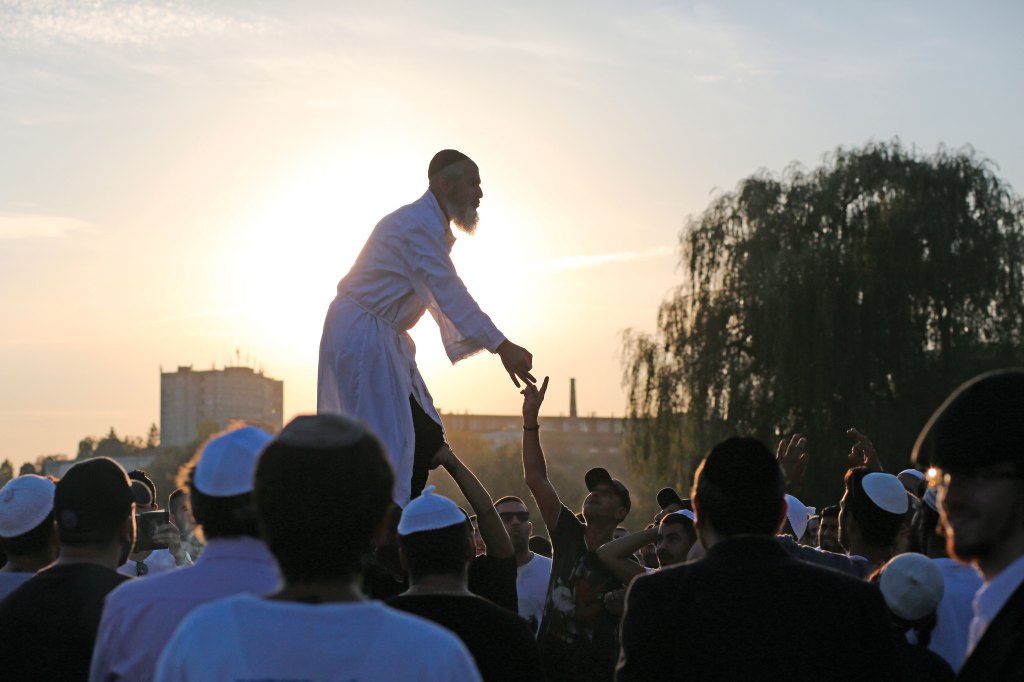This story appears in the April issue of VICE magazine. Click HERE to subscribe.
Pushkin Street has been transformed into a holy bazaar, and it’s crowded. Elbow to elbow, fur hat to fur hat, loudspeakers blaring out the chance to redeem your soul, stock up on groceries, or simply dance, dance, dance to the ecstatic music proclaiming God’s—and Rebbe Nachman’s—eternal greatness.
Videos by VICE
If you want any remote chance of getting to the counter at one of the makeshift falafel or shawarma stands knocked together for the benefit of the tens of thousands of pilgrims who’ve just arrived, you’ve got to bore through a morass of people waving shekels, dollars, and hryvnias like it’s 99-cent-drink night at the local dive bar. It’s a jungle out here, on the eve of Rosh Hashanah, the Jewish New Year, in Uman, Ukraine, the burial place of the 19th-century Hasidic mystic rabbi known as Rebbe Nachman of Breslov (in Hasidism, “rebbe” is an affectionate term for “rabbi” that also connotes a strong spiritual leadership). Nachman promised redemption for anyone who visited his grave, and for more than 200 years that grave has been the site of a fevered pilgrimage for Jews from around the world. In the past decade, the atmosphere has grown carnivalesque at times, as the followers of Nachman, traditionally Hasidim from religious upbringings, have swelled with former Deadheads, erstwhile Phish Phanatics, reformed criminals, and recovering (and sometimes not) alcoholics and drug addicts. The operative language is Hebrew, though you hear English, French, Yiddish, and Russian. The only ones speaking Ukrainian are the locals, who are allowed onto Pushkin Street if they can prove they live or work in the area, a measure meant, presumably, to ease crowding, but also to prevent violence between the native population and the tens of thousands of once-a-year religious tourists. As a result, Ukrainians are sparse, but they’re not the only ones: The pilgrims are all men. Here and there I notice posters in Hebrew slapped onto telephone poles and synagogue walls: it is forbidden in places where there are large gatherings of men for women to be found!

A Hasid who had been DJing on the eve of the New Year has traded his turntable for a ram’s horn, which he blows at the water’s edge on the second day of the holiday. Photos by Alexander Chekmenev
I watch a bearded Hasidic man in a white undershirt and green heart-shaped novelty sunglasses jump up and down and spin a record—imagine a techno beat with a synthesized voice chanting, “Rebbe Nachman, Nachman from Uman. Rebbe Nachman, Nachman from Uman.” Now imagine that keeps going for six minutes. All the while the man in sunglasses is shouting into a microphone, over the music: “Come on, redeem your souls! Come on, redeem your souls.” Shortly after, I notice the collective head of the crowd turn to watch something coming down the street. It’s a ram, preceded by two local peasant boys. They have come seeking to sell the beast to a hungry pilgrim. I follow them up the street, draping my jacket over my arm, since it’s 70 and sunny, and we turn off to the right. The peasant boys, the ram, and I are following two young Israeli guys who claim to be interested. They lead the ram and his tenders into a courtyard. Say they’ll be back in five minutes. And they’re gone forever. I tell the Ukrainian boys the Israelis have deserted, that they’ve been led on a wild goose chase. The boys, with their buzz cuts and roughneck faces, seem to be in a daze.
Since the boys speak only Ukrainian, I somehow end up as the middleman, translating and doing their bidding. Various merrymaking Jews approach, demand a half-price discount (one of the boys has a sign in English that reads 80 dollars), and then turn away. We wait in the hot sun; the ram is heaving with thirst. At one point, an Israeli man leads the beast and his boys to a nearby porch of a house he’s renting, to show it to a friend who might be interested. However, soon the Ukrainian landlord sniffs them out. He doesn’t want fresh blood staining his porch; he runs them all back onto the main drag, cursing and threatening to kick their ass. “People will come who’ll explain things to you. Painfully,” he says. I leave the three of them—the peasant boys and their ram—to their own devices. As I walk away, there are only a few hours left until the start of the holiday. The elder boy is making a phone call. “Pick us up,” he tells the voice on the other end. “We can’t sell the animal.” I have only just arrived in this city, and already I am exhausted.
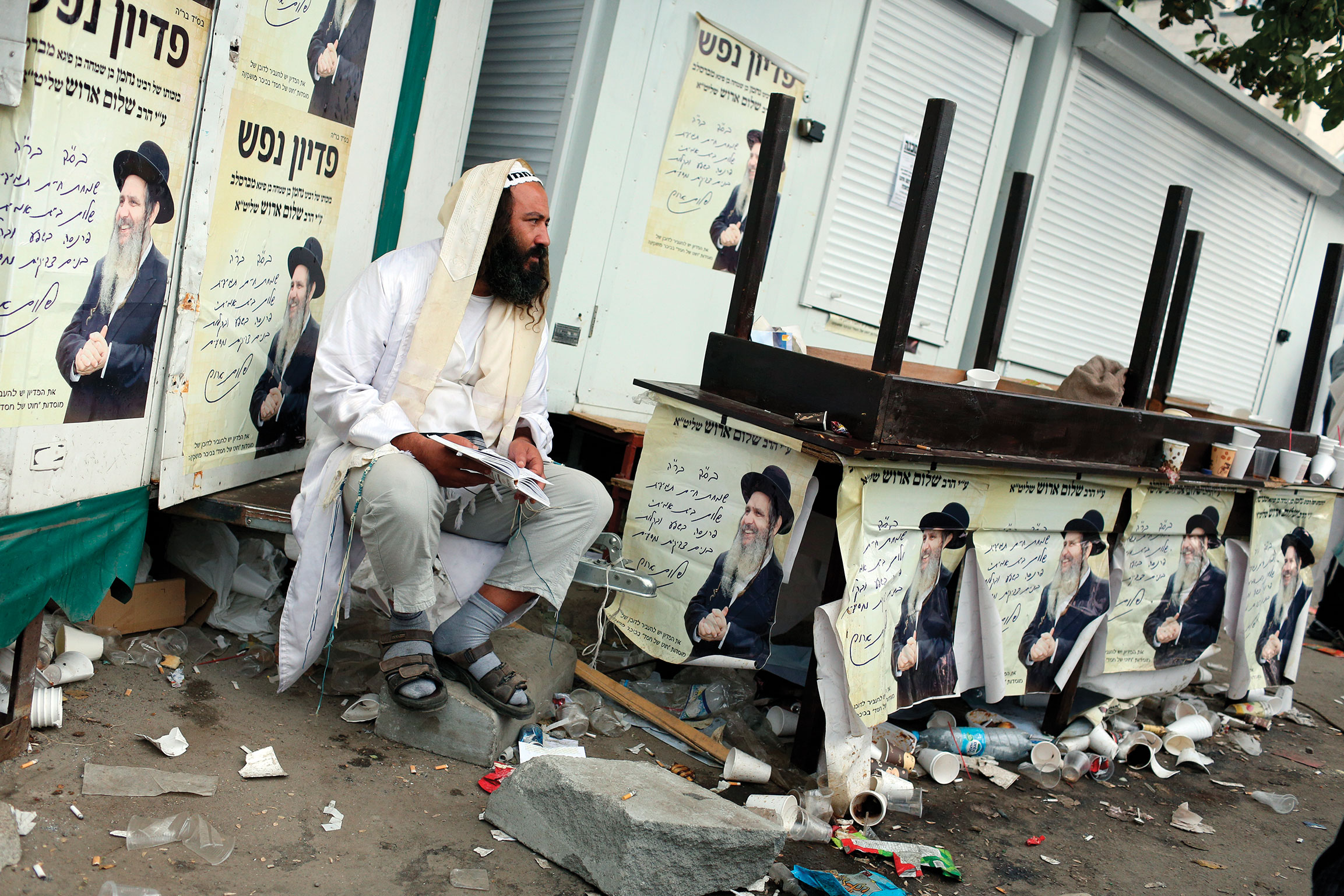
A pilgrim, surrounded by trash, prays on a side street off Pushkin. During the holiday, the city overflows with filth.
The Jewish history of Ukraine over the past hundred years is not a happy one. Though exact numbers are difficult to come by, in part because the territory of Ukraine is an ever-shifting Promethean thing, there were by some estimates about 2.5 million Jews within the borders of present-day Ukraine before World War II. Today, depending who you ask, the Jewish population is between 60,000 and 360,000, a result of exiles, exoduses, and exterminations. During World War II and the Holocaust alone, between 900,000 and 1.6 million Ukrainian Jews were killed. And since the unrest beginning in 2014, a significant number have fled to Israel. Even so, there are by some estimates a few thousand year-round Jewish residents in Uman; and the country is home to one of the largest Jewish populations in the world. But relations between Jews and Christians are sometimes tense, with the former often viewing their neighbors as persecutors, the latter as interlopers.
In fact, the very first pilgrimage to Uman happened in part because of anti-Jewish violence. The city is the site of a Jewish mass grave that dates to 1768, when rogue Cossacks murdered thousands of Jewish men, women, and children, leaving their corpses for pigs and dogs. Rebbe Nachman, the great-grandson of the founder of Hasidism, was said to have passed the city and asked to be buried there. Nachman, a controversial mystic in his own time, gained renown—and quite a few detractors in the deeply conservative Hasidic world—for emphasizing the here and now, a personal relationship with God, and the celebratory, rather than punitive, aspects of Judaism. Before he died in 1810, he promised his acolytes that if they came to pray at his gravesite he would “pull [them] out from the depths of Gehinnom” (hell). It was a revolutionary declaration, and since then, his adherents have been making the trip to his grave to hold him to his word.
Nachman attracted a dedicated but small following for the first century after his death—his brand of Hasidism was still very much an outlier in a Jewish world that was rapidly secularizing or entrenching more deeply into God’s commandments—and then the Soviets arrived on the scene. The visitors dwindled to a handful courageous enough to brave the Bolsheviks’ atheistic wrath. Then, in 1990, amid anti-Soviet protests in Ukraine, some 2,000 pilgrims celebrated the Jewish New Year at Nachman’s grave, the beginning of a resurgence that has grown larger over the past few decades.
For years, I had heard about Nachman, how he was a powerful magnet for the disenfranchised, the unclaimed, the irredeemable. To this day, he maintains that reputation. For many of the Jews who travel to this belly button of Eastern Europe, traditional Judaism, with its 613 Torah commandments and thousands of lesser laws—there’s literally a bundle of rabbinic opinions on the proper order to cut one’s toenails—has killed the spirit in favor of the letter. They seek fewer proscriptions, more dancing and song and mirth. And they want their souls saved. And since some of the followers are former acid-dropping festival rats, they also are known to have the best music. Curious to find out about this gathering of outcasts, I made the pilgrimage myself this past October.

A pilgrim snoozes outside a dining hall on Pushkin Street. Many visitors stay up all night praying, dancing, singing, and sometimes drinking. They sleep where they can.
With the help of a friend of a friend, I am renting a room in the house of a Ukrainian grandmother whom I never see without a traditional floral-print scarf over her hair. She lives with a rotating cast of plump granddaughters. The old woman, Zina, is delightful and speaks a melodious peasant Ukrainian. She makes, from scratch, fresh dumplings and borscht in the mornings and reads an old Bible at night. Zina doesn’t really have an opinion on the Jews who come to Uman every year, except that she can’t understand why they undertake such an expensive trip, coming from all over the world. “Our people would never spend so much money to visit a saint,” she says. The money I pay her for four nights of lodging—about $115—is nearly double her monthly pension from the state. The room I’m sleeping in is amply yet modestly furnished. It’s not until I notice the Christian Bible and the two bottles of ladies’ perfume in the formidable dark-wood china cabinet that I realize I have displaced Grandmother: She’s given up her bedroom for me and is sleeping with the granddaughters. Katya, who is around 20 years old, is working at a kosher cafeteria on Pushkin during the holiday, making about half a dollar an hour. She says it’s good work.
Jewish holidays begin at sundown, and this one lasts two days, from Sunday’s sunset to Tuesday’s, so when I walk back into town after tactfully turning down a dish of Grandmother Zina’s aspic, the New Year is already upon us. The loudspeakers have been hushed, and the hawkers have packed up their wares or closed their doors, since the use of electricity and the transaction of business are forbidden. There are several large synagogues on Pushkin, and men pray inside and on the street, in groups of a thousand and in small quorums. Mostly standing, some shout, jump, and bang on whatever is close at hand, and some whisper intimate thoughts to the Almighty. Others simply watch the crowd or schmooze with friends. The synagogue that holds Nachman’s grave is right off Pushkin Street, on Belinsky Street. The crowd is denser here than anywhere else in Uman. I will attempt a dozen times over the course of the holiday to see the grave, to no avail. On that first night, I am taken with a scene in the synagogue’s courtyard—as close as I can get, for the flood of people heading inside is impossible to wade through. On the synagogue roof, a dozen men and boys are dancing. In the moonlight, it looks like a scene from Fiddler on the Roof. Below, in the courtyard, all eyes are turned toward a man sitting on a wall, surrounded by devotees drinking in his every move. This, I soon find out, is Moroccan-born Israeli rabbi Shalom Sabag, a man who came from a secular past and is now considered one of the leaders of Breslov Hasidism. One Israeli newspaper described Sabag’s gathering as the “Tony Soprano minyan [prayer group].” Surrounding him are acolytes, fans, Hasidim in black gabardines and moderately religious North Africans in jeans and T-shirts, boys with sidelocks and young men who, save the yarmulkes, could be mistaken for Phish fans, with their colorful garb, their scraggly beards, and their sun-bleached hair. Sabag sits there chanting soundlessly like a silent martyr, his head wrenching this way and that as if in a trance, eyes squeezed shut, beard mostly gray. I feel as though I’m in a bizarre French New Wave film, with the central character a study in sainthood.
Nearby, I chat up two Ukrainian cops. There is a heavy police presence here. In 2010, an Israeli was stabbed and killed, and though anti-Semitism in Ukraine is low by most standards, some worry that with the recent tumult and Russian invasion, it could be on the rise. Every year, Israel sends a few police officers to help keep the peace; recently, they went with a squad of 15, including a combat medic and a bomb-disposal expert. Mainly, I see them stationed at the cross on the hill overlooking the Jewish quarter. The cross was put up a few years ago and has been the source of much tension since its erection. Not long after its appearance, a group of Jews tried burning it down but failed. Since then, it’s been under heavy guard.
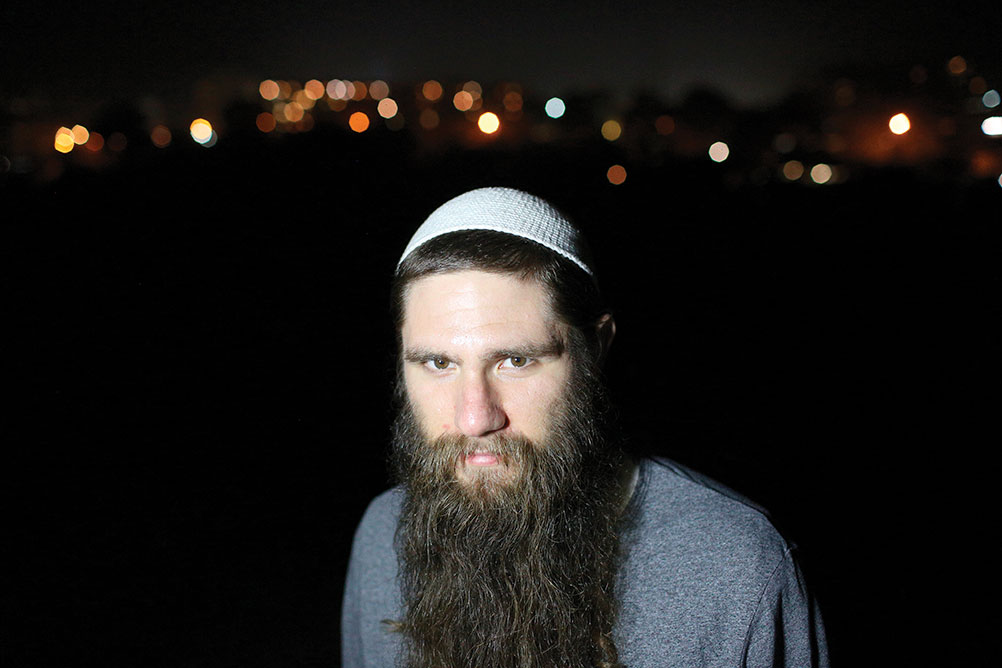
Chezi from Atlanta, who grew up secular and whose wife divorced him because he used to wake up on purpose in the middle of the night to study scripture.
I ask one Ukrainian officer, a good-looking young man with sandy hair and a slight Slavic nose, what his main task is. “Making sure there are no bombs,” he says. “And no pork.” Mostly, though, at least to my eye, the police’s function seems much more pedestrian. While it is permitted to smoke on Rosh Hashanah, Jews are not allowed to create fire. That means that you can inhale to your lungs’ despair, but you can’t light up. A non-Jew must light it for you, or you can light it off somebody else’s already-lit cigarette. The cops I see spend a lot of time flicking lighters; often, they cadge a cigarette in return. As I’m about to leave, the policeman I’d been talking with asks me if I’ve ever lived in Israel. Yes, I tell him. “Is it as dirty there as it is here?” he asks me. Everywhere you look in Uman, there’s trash.
I sleep a sleep of nose-stuffed agony. The city is filthy. Dusty, swarming with Styrofoam coffee cups and cigarette butts, plastic bags and trampled napkins. The garbage receptacles are overflowing; there is literally dirty toilet water running through the streets. The city of Uman can accommodate 5,000 tourists. According to which figures you go by, there are between 30,000 and 60,000 tourists this year. And trouble has been brewing since even before people arrived in Uman: At the Kiev airport, some pilgrims managed to take over the PA system and blast Hasidic tunes; impromptu dancing broke out, with people chanting through bullhorns. It is because of incidents like these, and a general negative attitude I observed by many of the Hasidim toward the locals, that many Ukrainians resent the tourists, though they acknowledge they bring with them a boost for the economy.
But there’s a price to pay for all these tourist dollars, shekels, hryvnia. In Uman, the sewers are backed up, the electric grid is overtaxed, and there are not enough garbage trucks to properly maintain order. When I meet with the vice mayor, Liudmyla Kyryliuk, she tells me that the Rabbi Nachman of Breslov Charitable Foundation contributes about $23,000 to things like street cleaning, garbage removal, additional water supply, and emergency services. It is apparent that this is woefully inadequate. Around Pushkin, people are bedding down in nooks and crannies, sleeping in tents they’ve set up in side streets, or crammed into rows of bunk beds in shacks and garages with no running water or electricity. This means, among the coffee cups and potato chip bags and plastic sacks full of vegetable trimmings and paper plates, there’s a hell of a lot of soiled toilet paper, as many “accommodations” have no toilets. People shit where they can. And you’d be surprised where they can. Several people describe Rosh Hashanah in Uman to me as the Burning Man of the Jewish world. I think at Burning Man they must have better toilets—and better drugs. One guy I talk to asks me if I have any weed as soon as I turn off my recorder; later, I meet plenty of people who might have been his supplier, turning off into bushes or back alleys to smoke a joint, always careful, however, to only take a light from an already burning roach.
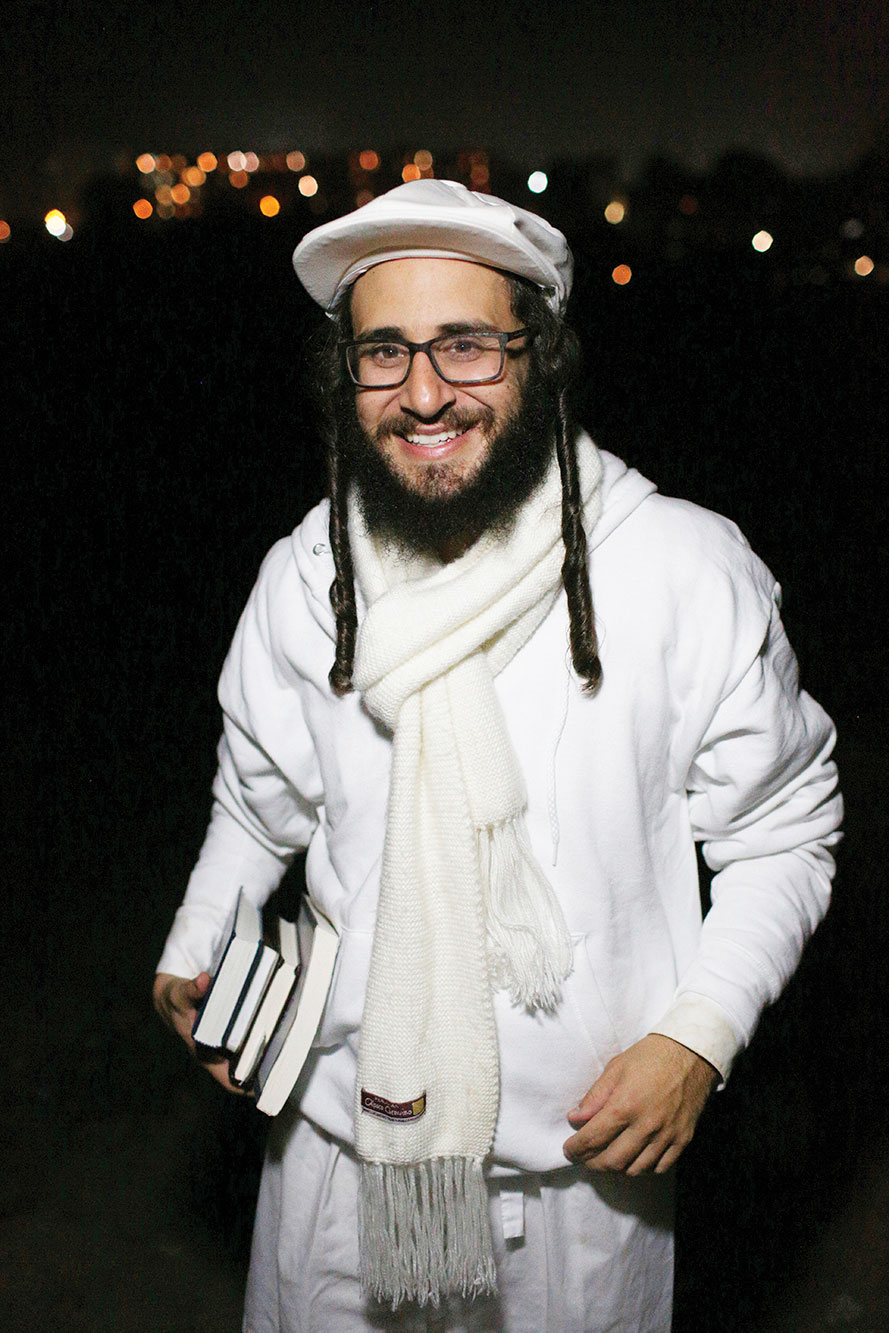
Yaakov Lehman, who tried Sufism, Daoism, and the Hare Krishna movement, among others, before settling on Breslov Hasidism.
The next day, I wander down the main drag and soon find myself descending to the nearby lake, another popular spot for prayer and dance. Water, in Judaism as in so many other religions, is a purifying element, and many take a ritual bath at this spot. I meet two Americans who quickly invite me to their place for lunch. It’s a ten-minute walk, and once we turn off the main lakeside road, I’m relieved to find that the crush of the crowd is noticeably less here. Take that sentiment with a grain of salt: When we arrive at our destination, there are 35 guys staying there. You can hear song and prayer wafting from the other houses on the street, and even from across the water, from Pushkin Street. But in the yard of the house owned by a Ukrainian woman named Lida, there are rabbit hutches, a chicken coop, and a few square yards of relative calm.
This is “Yoni’s place”; Yoni is Yonatan Hirschhorn, an Israeli who is now a rabbi at the University of Maryland Hillel. He’s a small guy, with light-blond hair and sidelocks that curl around his chin like a ram’s horns. He wears a perpetual smile laced with preoccupation, for even as he comes out to welcome me he must also see to it that the massive amounts of food are being prepared on time, the toilet isn’t stopped, the guests are being hosted, the drunk and toothless Ukrainian cutting dozens of peppers doesn’t slice off his finger, and that the spirit of Uman is pervading his temporary home. A blue tarp stands in for a wall that was meant to enclose a dining room but wasn’t built on time for this year’s gathering. There’s water an inch deep on the bathroom floor—from clogged drains or sloppy showers, I’m not sure—and the men sleep four or six to a room.
To the naked eye, you can see how things are built chockablock here. You look at shoddy new construction, and you worry that soon something terrible will happen: A roof, a wall, an entire foundation, will collapse, and the loss of lives, and of course the financial consequences, could be disastrous. But whose job is it to make sure building codes are followed? The tourists’, the residents’, city officials’? Many Ukrainians tell me that the new government is even more corrupt than the last one. Former president Viktor Yanukovych was a “bandit,” they say, but at least he left something for the people. The new leadership takes everything. Presumably, that means that with a bribe to the right people, licenses can be obtained, shabby construction overlooked, and city ordinances ignored, with not much capital trickling down to ordinary citizens.

Jews of all backgrounds—from born-into-it Breslov Hasidim to reformed acid droppers and erstwhile lost souls—eat challah and grilled meat at “Yoni’s place,” a guesthouse where about 35 pilgrims stayed during their trip.
There are elements of Breslov that remind me of au courant meditation movements, New Age solo therapies that focus on mindfulness and quality interpersonal relationships. Yoni explains that, for members of the Breslov community, religion means that “instead of being motivated by fear, we are going to be motivated by faith and relationships.” There is a willingness to forge relationships with segments of the population that might be considered “dangerous” by the rest of the Orthodox world—for instance, an apostate reporter and a Ukrainian photographer, or ex-criminals and former drug addicts—whom the pilgrims are ready to embrace. “Reb Nachman said, ‘The whole wide world is a narrow bridge, and the most important thing is not to be afraid,’” Yoni tells me. These words of the rebbe are frequently set to music—mainly bass-heavy house and techno—and they seem to bounce back from the heavens and reflect off the water so that they land right in my ears wherever and whenever I am listening.
When I come back for dinner, I bring Alexander Chekmenev, the Ukrainian photographer I’m working with on the story. One guy from Atlanta named Chezi, who grew up in a secular family but is now very observant, wants me to convey thanks to the Ukrainians for allowing Jews to come here, to Uman, and for being so gracious. He wishes that more of the pilgrims were respectful toward the locals. He wants to explain the historical motivations behind the resentment some of the Jews display, how they see the police and the soldiers—and how they’re afraid from channeling hundreds of years of oppression. He also points out that perhaps the children misbehave because there are no mothers here, as women aren’t allowed. And there’s no shortage of bad treatment: The day before, I’d seen three young religious boys walking along the road that bridges the water, making a friendly face at the Ukrainian policemen hanging out the side of their van. “ Kelev tov, kelev tov,” one of the boys said to them, a smile on his face. One Ukrainian waved back, smiling, not knowing that he’d just been called a “good dog.” Alex, a local selling winter jackets in the marketplace without much luck, tells me later that the Jews aren’t quite respectful of him. “They speak to me with definite condescension,” he says. “Honestly, I understand why these people broke off from Christ.”

Serhiy Alekseev, a city deputy, has developed a reputation as being tough on the Hasidim who come to Uman.
Back at Yoni’s place, I am introduced to another pilgrim, Yaakov Lehman, who is dressed almost angelically in white, with a coal-black beard, a young face, and an easy smile. He’s a worldly man, with degrees from universities including the London School of Economics. He grew up, secular, in Tucson, then Santa Barbara, and characterizes himself as a “psychedelic Bolshevik” in his younger years, “into revolution, into altered consciousness.” Now founder of a company called Wisdom Tribe, which aims to incorporate ancient wisdom into today’s corporate culture, Lehman came to Orthodox Judaism—as Jacob, back then—in a serious way ten years or so ago, after he’d “danced with the Hari Krishas [ sic], breathed pranayama with the yogis, blissed out with the Sufis, and fired up incense with the Daoists.” He was reluctant to talk with me on the record about his past, but he has written publicly of his eventual embrace of his ancestors’ religion elsewhere. “In the end,” Lehman writes in a Medium post, “it was a non-Jewish friend from high-school, who after fleeing from a hit placed on his life by the Mexican Mafia, set me on the path to exploring my roots. While seeking refuge at my house in Santa Barbara, [my friend] was walking through a field one day and encountered a rabbi planting trees in a field on the Jewish eco-holiday of Tu Bshvat.” Lehman’s relationship with the rabbi eventually induced him to move to Israel and study in a yeshiva. He’s been living in the Holy Land ever since.
While a student at the University of California in Santa Barbara, Lehman founded a music festival called Chilla Vista, which continues to this day. “I’ve always been drawn to ecstatic expressions of humanity, in particular in a social setting, in gatherings of large amounts of people for causes,” he says, noting the similarities between the music festival and the pilgrimage. His master’s thesis at the University of Vienna was on the desecularization of the contemporary world. He is perhaps proof positive of his own thesis. And he’s not the lone example: When I get home, I find yet more affirmation that religion is not quickly disappearing from the world: Grandmother Zina is seated at the kitchen table, reading the family Bible.
“Good night, Rossik,” she says. “Are you hungry?”
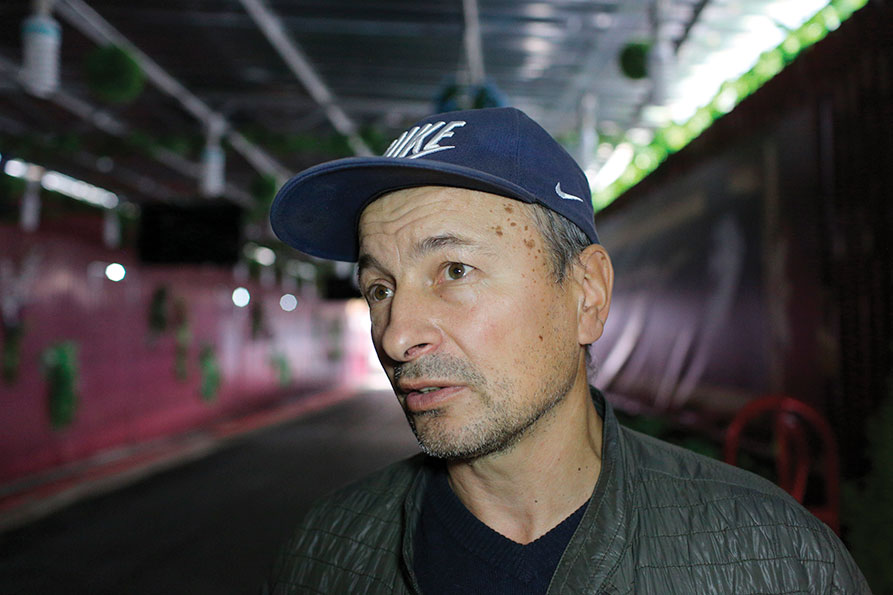
The idea to build a giant cross on a hill overlooking a site of Jewish pilgrimage came to Valeriy Kislinski, pictured here, in a dream.
On the final day of Rosh Hashanah, I meet Serhiy Alekseev, a city deputy. He’s one of the only Ukrainians I encounter in the Pushkin area who’s not working in a dining hall, policing the streets, or transporting supplies. He’s a stocky, beefy guy; he looks like a carpenter or an electrician. Alekseev is aligned with the Svoboda Party, which has been widely criticized over the past few years for being xenophobic, nationalistic, and anti-Semitic—the World Jewish Congress even went so far as to call it a neo-Nazi party in 2013. Members of the party have challenged these claims. Alekseev tells me that people “elect a person, not a party,” and that anyway, Svoboda is more or less “normal.”
The deputy is piping mad about the state of the pilgrimage to Uman. He’d been in the news a few months prior for knocking down an illegally built store on Pushkin Street, and he has developed a reputation as being tough on the Hasidim who come to his city. In January 2016, the media reported—and video would seem to support the claim—that a Hasidic man pulled a knife on Alekseev after an argument about clearing a path for a snow plow got out of hand. He proposes to me a limit of 5,000 people at one time for Rosh Hashanah, who would be bused in, pray, and then be bused out, to allow for another group of pilgrims to get their prayer fix without overburdening the city’s infrastructure. Alekseev takes me on a two-hour tour, pointing out the trash, the toilet paper, and what he claims to be building-code violations. He also comments on “the people walking in the piss, the shit” that flows to the lake. He mentions the fact that the pilgrims aren’t screened for health risks at the airport; several times, he points to somebody nearby and wonders if the accused has tuberculosis. Never mind the fact that the TB-incidence rate in Ukraine is 91 per 100,000; in Israel and the US, where the majority of pilgrims are coming from, the rates are 4 and 3.2, respectively. But Alekseev has a point when he talks about the overloaded infrastructure, the bribery, and the corruption that allow local ordinances to be overlooked or ignored. As we pass by blocked drains, runnels of raw sewage, and tents along the lakeshore, I begin to sympathize with his fury, if not agree with all the targets of his anger. “It’s business. It’s not faith,” he says of the pilgrimage. Yet as angry as he is with the Hasidim, it’s his own government officials he’s truly furious with. They’re all bought and sold, he tells me, as we make our way from the Jewish quarter to the cross on the hill. A simple bribe to the right person in Kiev allows a builder to eschew all codes and norms. “We live in a feudal system.”
The controversial cross was Valeriy Kislinski’s idea, many years ago. Kislinski, whom Alekseev introduces as his assistant, is a skinny guy with a baseball cap cockeyed on his head and a few days’ worth of gray stubble on his face. Kislinski is a stark contrast to his boss—he speaks slowly, unsurely, and while Alekseev is like a bull racing through the town, Kislinski is more a fly hovering at the flanks. The religious vision came to him in a dream—put a cross on the hill by the water—and a while later, he brought up the matter to a council of activists and NGOs. He says they liked the idea because “those foreigners [would] know where they are, that they are on our territory.” Kislinski insists this was not his intention, and the erection of the cross was delayed for a couple years because of that disagreement. He says the whole notion that a cross can be “against somebody” is anathema to Christianity and adds that it was just the right site, perhaps even God’s will. But when he and several others, including Alekseev, finally put up the cross in 2013, there was an uproar, with both city officials and Jewish leaders declaiming what they called a provocation.
Ukrainian and Israeli police are on guard here atop the hill, and the atmosphere is tense as Alekseev shakes hands with the Ukrainians, who know him by sight, then gets down on his knees and kisses the splayed figure of Jesus on the wooden cross. From our vantage point—and from Christ’s—we’re looking down on literally thousands and thousands of Jews gathering at the banks of the water. It’s hard to see how the idea of this cross being put right in this place wouldn’t be seen as an act of provocation. But maybe Kislinski, if unwittingly, is making another point. There’s more in common here than the two sides are willing to admit. Jesus and Nachman—two eccentric rabbis, both dead in their 30s, both outcasts, both rejected by their coequals, both magnets for the disenfranchised, the weak, the spurned, the suffering. But I don’t think that’s what he was getting at.
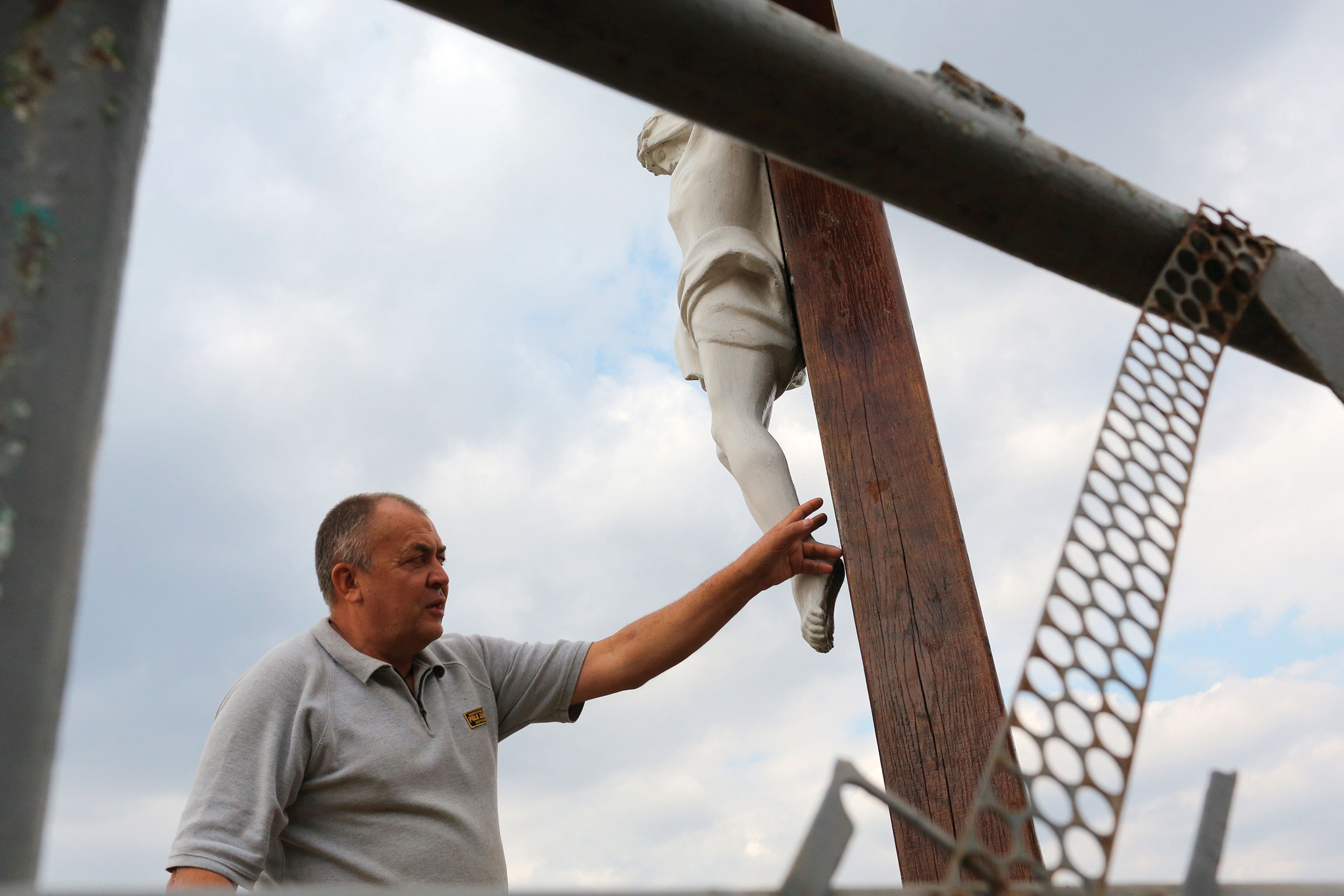
Alekseev touches the controversial cross.
Sundown, and the holiday is over. I am eager to leave this place, eager to leave the trash, the crowds, the songs, the reverie, the dust. Hungry for silence and tranquility that are not granted at the airport, on the plane, or at the baggage claim. Everywhere on my return journey, from Uman to Kiev to Istanbul to New York, there are returning pilgrims. As we’re taxiing to the gate at JFK, a pilgrim wearing a medical mask dashes down the aisle. “Sir, you must remain seated,” the exasperated stewardess tells him. He sits. Right there in the aisle, in front of the bathroom, as others clap and cheer his wily cleverness.
This is emblematic of what I’ve seen over the past few days. I expected to find raucous crowds, chaos, even rampant prostitution. The crowds were friendly, there wasn’t necessarily chaos so much as disorder, and I didn’t see any trends in prostitution that wouldn’t be found in your home city or mine. What I did find, however, were individuals who were friendly and welcoming and warm toward me, a fellow, if fallen, Jew, and at the same time often quite nasty and disrespectful toward their Catholic and Orthodox Christian hosts. And I can’t say that this feeling wasn’t returned in kind. It’s difficult to disentangle hundreds of years of bad blood between peoples, and perhaps it’s asking too much of the pilgrims to return to a country their forefathers were exiled from—or worse—and behave as if history hadn’t happened.
I wonder if we’re at a breaking point, and a few months later, I am saddened and horrified, though not completely taken by surprise, to learn that a group of Ukrainians—who witnesses claim had shaved heads and shouted anti-Semitic epithets—have broken into Rebbe Nachman’s gravesite and desecrated it with a pig’s head. There is a swastika carved into its forehead, and several Israelis are reportedly hospitalized in the attack. Then, on New Year’s Eve, the Jesus icon is torn from the infamous cross, reportedly in retaliation for the pig’s head. I think back to Lehman and Yoni and Chezi, and the admirable way they conducted themselves while guests in a foreign land, and I wonder if they’ll be back next year. And then I wonder if Kislinski is dreaming again.
